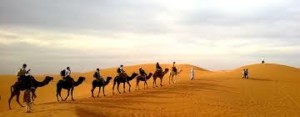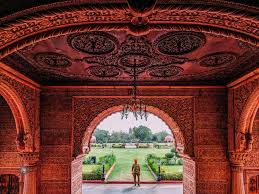 A thriving city across the Rajasthan desert
A thriving city across the Rajasthan desert
The deserts fascinate from a distance but it is only the true lovers of sun and sand who make it their homes and create miracles smack in the middle of the dry arid land mass. The city of Bikaner narrates a similar tale of hardship and bravery of the founder, Rao Bikaji, a descendant of Rao Jodhaji.
Bikaner city was founded in 1488 from Jangaldesh or the country of wild bushes. It has been almost 550 years since its inception and the city has spread across the desert and has also acquired expertise viz, camel breeding and dry irrigation which is unique to it. Bikaner city along with its rocky scrubland is located on an elevated plain in the desert. The old city is encompassed by a long embattlement wall which intermittently breaks to give way to five huge gates. Now a major trade center for wool, building stones, carpets, blankets, salt and grain, Bikaner has emerged as the lifeline of the state.
The handicraft industry of Bikaner and especially the ivory and lacquer ware articles are exquisite. The city acquires a yellowish red hue from the presence of various red and yellow sandstone buildings. The fortified town has a medieval charm about it which oozes from every street traversed by the tourists.
Bikaner is renowned for the innovative idea of the filter (intricately carved Jharokas) specially created to provide the womenfolk with a window to view the proceedings outside whilst being hidden.
Apart from the regular tourism features associated with the desert, Bikaner boasts of a unique thriving market of various Rajasthani art forms. The taste buds can be satiated with a wide assortment of Bhujias, Rasgullas, Papad and Thandai. The Usta art of miniature paintings and gold embossing which is undertaken upon the ceilings, walls, pillars of buildings as well as wooden & glass items and ivory is a specialty of Bikaner.
Tourist attractions
 Gajner Palace:
Gajner Palace:
The Royal family of Bikaner has created many architectural marvels in Bikaner. The Gajner Palace, often remembered as ‘a jewel in Thar desert’, was conceptualized as a summer resort for the royal families.
Junagarh Fort:
The famous fort of Junagarh was constructed by Raja Rai Singh in 1593. The fort is one of its kind with a strong, innovative and formidable structure which is encircled by a water moat which is believed to have bred crocodiles in the past. An amazing network of Havelis with courtyards and balconies, watch towers, armory and halls, the fort exudes an aura of red sandstone (Dulmera) and marble. The grand fort has a long rampart which is almost 1000m long and is studded with 37 bastions and two entrances.
Lallgarh palace:
The Lallgarh Palace named after Maharaj Lal Singh is an architectural marvel in red sandstone, dedicated by his loving son, Maharaja Ganga Singh. The palace has been tastefully designed and decorated with liberal help from the British designer Col Swinton Jacob.
Sadul Singh museum:
The Sadul Singh Museum covering the entire first floor of the Lalgarh Palace is dedicated to the lives and exploits of three successive kings of Bikaner, Maharaja Ganga Singh, Sadul Singh and Karni Singh. The Museum depicts these three kings and their passions through numerous artifacts, displays as well as photographs and life size paintings in more than 20 rooms. The royal family of Bikaner still resides in one part of the palace.
Jain temple:
One of the distinct monuments of Bikaner is the famous Jain temple dedicated to the 5th Tirthankar of the Jain religion, Shri Sumati Nath ji. The temple constructed in the 15th century is one of the oldest shrines in the area.
Karni Mata temple:
One of its kind, the Karni Mata temple at Deshnoke is world famous for it’s; hold your breath, rat worship. Thousands of black, grey as well as the special white rats (kaba) reside within the shrine premises. The temple is 600 years old and it is widely believed that feeding the rats at this temple and getting touched by them would bring good fortune.
Kote Gate:
The chronic shopaholic never misses the whiff of local market food stuff and the bylanes which are hidden from the world, carving out magnificent masterpieces for throwaway prices. The Kote Gate in Bikaner is one such place which is full of surprises for the ardent shopper. Being a part of history has endowed Bikaner with numerous art forms and handicraft artisans who produce creative wonders relentlessly.
Station Road:
Bikaner’s dusty streets and rustic bylanes are replete with numerous shops and small time vendors ready to sell their wares for a price. What is required is little bit of bargaining ability and a lot of patience, of course along with some money. The Station Road market is one such fabulous place where it is possible to acquire embroidered footwear (Jootis), local fabrics, leather goods and wood as well as traditional artifacts.
Best time to visit:
Generally Bikaner has both extreme climates, hot and cool. The best season to visit this place is between October to March.
How to reach
By train: Bikaner railway station is well connected to the cities of Delhi, Jodhpur, Jaipur, Kalka and Bhatinda. Bikaner Express and Bikaner Mail are commonly preferred trains.
By air:
The nearest airport to Bikaner is Jodhpur, which is 250 km away. This is a domestic airport, connecting to metros in India and some few other cities in North.
By bus:
Plenty of bus services are available from Bikaner to Delhi, Jodhpur, Agra, Ajmer, Ahmedabad, Jaipur, Jhunjhunu, Jaisalmer, Barmer, Udaipur and Kota.







